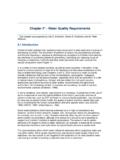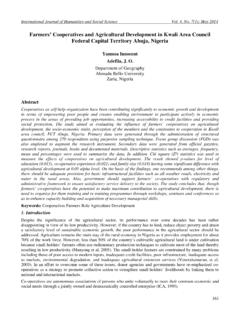Transcription of SURGICAL WORKFORCE IN NIGERIA - who.int
1 I C=68 M=85 Y=0 K=26C=68 M=85 Y=0 K=26 CASE STUDY | NIGERIASURGICAL WORKFORCE IN NIGERIAS tock and flow of medical and dental practitioners in NIGERIA , with special focus on health WORKFORCE training in Cross river stateii BRAIN DRAIN TO BRAIN GAINThe authors of this report are Peter Eriki,1 Angela Oyo-Ita,1 Robert Odedo,1 Anthony Udoh,2 Francis Omaswa,1 Patrick Kadama1 African Centre For Global Health and Social Transformation, all rights reserved. Comments on an earlier draft were provided by James Buchan (University of Technology, Sydney) and Giorgio Cometto and Ibadat Dhillon (WHO). December 2015 1 1 African Centre For Global Health and Social Transformation (ACHEST)2 Federal Ministry of Health, NigeriaContents Acknowledgements.
2 21. Background ..3 Human resources for health characteristics and challenges, NIGERIA ..3 Cross river state ..4 Human resources for health policy environment in Objectives ..53. Methods ..54. Results: national-level analysis on entry, exist, and exit ..6 Entry ..6 Exist ..6 Exit ..7 Specialist SURGICAL health WORKFORCE in Results: health WORKFORCE training in Cross river state ..8 Mapping and analysis of pre-entry health WORKFORCE stakeholders ..8 Training of medical doctors ..8 SURGICAL WORKFORCE .
3 9 Training of nurses ..9 Training of midwives ..9 Training of medical laboratory scientists ..96. Discussion ..10 Health WORKFORCE training in Cross river state ..117. Recommendations and conclusions ..12 References ..12 1 3 Acknowledgements The African Centre For Global Health and Social Transformation (ACHEST) would like to acknowledge the support received from various stakeholder institutions and individuals that facilitated the implementation of project activities in NIGERIA : the Permanent Secretary/acting Minister of Health, Federal Ministry of Health and all the colleagues at the federal level, councils, development partners, and, in Cross river state, all the officials from the state Ministry, University of Calabar Teaching Hospital staff, and stakeholders who participated and actively contributed during the conduct of the study are thanked immensely for their for the development of this report was provided through the project Brain Drain to Brain Gain.
4 Supporting the WHO Code of Practice on International Recruitment of Health Personnel for Better Management of Health Worker Migration, co-funded by the European Union (DCI-MIGR/2013/282-931) and Norad, and coordinated by WHO. The contents of this document are the sole responsibility of ACHEST, and can under no circumstances be regarded as reflecting the position of the European Union or BRAIN DRAIN TO BRAIN GAIN 3 Case study on the stock and flow of medical and dental practitioners in NIGERIA , with special focus on health WORKFORCE training in Cross river stateNIGERIA1. Human resources for health characteristics and challenges, NigeriaNigeria has one of the largest stocks of human resources for health in Africa.
5 Yet, it is still inadequate to meet the coun-try s needs. In 2006, an inventory of health care personnel indicated 39 210 doctors ( per 1000 population), 124 629 nurses ( per 1000 population), 88 796 midwives ( per 1000 population), 2482 dentists ( per 1000 popula-tion) and 12 072 pharmacists ( per 1000 population) for the year 2004, less than the minimum recommended by the World Health Organization (WHO) (1).The main factors underlying human resources for health challenges in NIGERIA include (a) insufficiently resourced and neglected health systems; (b) poor human resourc-es planning and management practices and structures; (c) unsatisfactory working conditions characterized by heavy workloads, lack of professional autonomy, poor su-pervision and support, long working hours, unsafe work-places, inadequate career structures, poor remuneration, poor access to needed supplies, tools and information, and limited or no access to professional development op-portunities; and (d) internal and international migration of health workers.
6 These challenges have contributed to inequitable distribution of the existing health WORKFORCE with lower levels of care in rural areas, with the northern parts of the country particularly disadvantaged (2).In addition to challenges related to internal human resourc-es for health mobility and inequities, NIGERIA is also one of several major health WORKFORCE -exporting countries in Africa. Recent Organisation for Economic Co-operation and Development (OECD) data identified NIGERIA as the leading African source of foreign-born nurses practising in OECD countries; and one of the three leading African sources for foreign-born physicians (3). Inadequate infra-structure, poor working conditions and poor compensation packages have contributed to the emigration from the coun-try of a sizeable number of surgeons, physicians, nurses and other medical professionals.
7 For example, health workers in NIGERIA typically earn about 25% of what they would earn if they were working in North America, Europe or the Middle East (4). The sustained trend in brain drain from the health system in NIGERIA has in particular contributed to acute shortages of specialized and experienced health professionals in the country. Related to the problem of brain drain is the problem of geographical distribution of health care professionals. BRAIN DRAIN TO BRAIN GAIN4 BRAIN DRAIN TO BRAIN GAIN 5 There is a disproportionate concentration of medical professionals in urban areas. While access to medical personnel is readily available in cities, rural dwellers often have to travel considerable distance in order to get treatment.
8 Doctors and nurses are reluctant to relocate to remote areas and forest locations that offer poor commu-nications with the rest of the country and few amenities for health professionals and their families. Urban areas in NIGERIA are more attractive to health care professionals for their comparative social, cultural and professional advantages (2). Cross river state Cross river state is situated within the Cross river basin in the south of NIGERIA . Health indicators are generally poorer than for other southern Nigerian states; for exam-ple, while skilled birth attendance rates are over 75% in the southern states of Abai, Anambra, Ekti, Imo, Lagos, Ogun and Ondo, the skilled birth attendance rate for Cross river stands at only 45% (5).
9 Cross river has 295 primary health care facilities, 15 general hospitals, 130 private hospitals and 2 tertiary health care facilities. The tertiary facilities the University of Calabar Teaching Hospital and the Federal Neuropsychiatric Hospital, Calabar are owned by the federal government, while the primary health care facilities and general hospitals are owned by the Cross river state Human resources for health policy environment in NigeriaIn order to address human resources for health challeng-es and constraints and achieve targets for NIGERIA , the Federal Ministry of Health in 2006 developed the National Human Resources for Health Policy.
10 Followed in 2007 by the National Human Resources for Health Strategic Plan to guide the implementation of the policy at all levels. In 2010, the National Human Resources for Health Strategic Plan was incorporated into the National Strategic Health Development Plan (2010 2015). The human resources for health policy and plan include a range of strategies, approaches and interventions aimed at improving policies, systems, capacity, structures and processes for human resources for health at both the strategic and operation-al levels to ensure the production and distribution of adequate numbers of appropriately skilled and motivated health workers.














